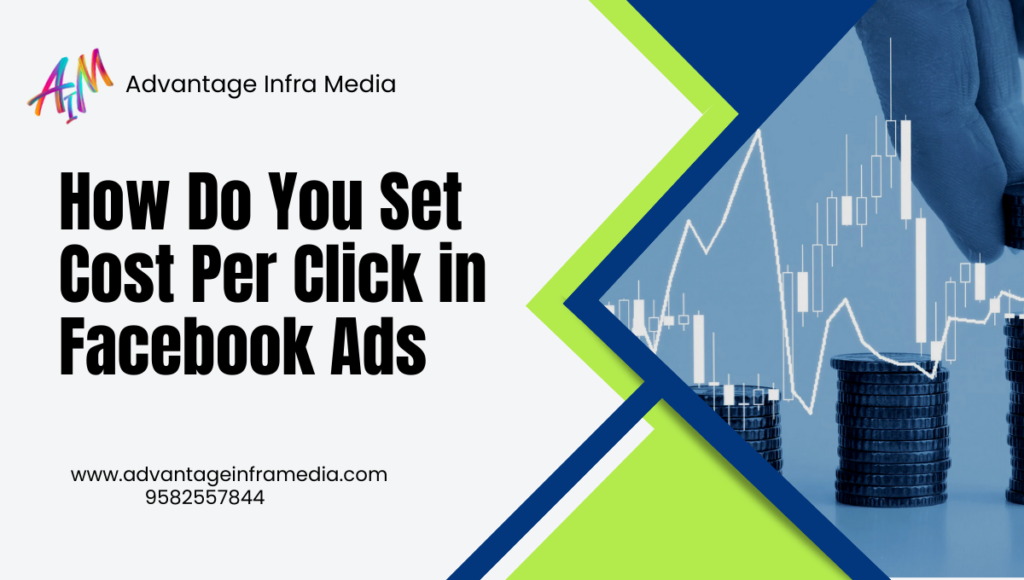How Do You Set cost per click in Facebook ads in 2024
Introduction
Cost Per Click (CPC) is a critical component of pay-per-click (PPC) advertising, a model where advertisers pay each time a user clicks on one of their ads. Setting the right CPC is essential for maximizing return on investment (ROI), driving targeted traffic, and achieving advertising goals. In this comprehensive guide, we will explore the key factors and strategies for setting an effective CPC, including understanding the PPC ecosystem, researching keywords, analyzing competitors, leveraging bid strategies, and continuous optimization. (How Do You Set cost per click in Facebook ads)
Understanding the PPC Ecosystem
Before diving into CPC setting, it’s essential to understand the broader PPC ecosystem. PPC advertising platforms, such as Google Ads and Bing Ads, operate on an auction-based system where advertisers bid on keywords relevant to their products or services. The primary components of this system include:
- Keywords: Words or phrases that trigger the display of your ad.
- Ad Rank: A value determined by your bid amount, ad quality, and relevance.
- Quality Score: A measure of the quality and relevance of your ads and keywords.
- Maximum CPC: The highest amount you’re willing to pay for a click on your ad.
Setting Objectives and Budget
Before setting your CPC, it’s crucial to define your advertising objectives and budget. Your objectives might include increasing website traffic, generating leads, or boosting sales. Your budget will determine how much you can spend on PPC campaigns, which directly impacts your CPC settings. (How Do You Set cost per click in Facebook ads)
1. Defining Objectives
- Brand Awareness: Focus on broad keywords and high impressions.
- Lead Generation: Target specific keywords with high conversion potential.
- Sales: Aim for keywords that drive purchasing decisions.
2. Establishing Budget
- Determine your overall marketing budget.
- Allocate a portion of this budget to PPC advertising.
- Consider daily and monthly spending limits to control costs.
Keyword Research
Keyword research is the foundation of setting an effective CPC. It involves identifying the right keywords that align with your business goals and target audience. Here’s how to conduct thorough keyword research: (How Do You Set cost per click in Facebook ads)
1. Brainstorming
Start by brainstorming a list of relevant keywords related to your products or services. Consider the language your potential customers might use when searching online.
2. Using Keyword Research Tools
Utilize tools like Google Keyword Planner, SEMrush, Ahrefs, and Moz to find additional keywords and gather data on search volume, competition, and average CPC.
3. Analyzing Competitors
Examine your competitors’ keywords to identify opportunities and gaps. Tools like SpyFu and SimilarWeb can provide insights into your competitors’ PPC strategies. (How Do You Set cost per click in Facebook ads)
4. Categorizing Keywords
Group your keywords into categories based on relevance and intent. Common categories include:
- Brand Keywords: Keywords that include your brand name.
- Product Keywords: Keywords related to specific products or services.
- Generic Keywords: Broad keywords that describe your industry.
- Long-Tail Keywords: Longer, more specific phrases with lower search volume but higher conversion rates.
Analyzing Competition
Understanding your competition is crucial for setting the right CPC. Competitive analysis helps you gauge the landscape and identify the CPC range within your industry. Here are steps to analyze competition:
1. Identify Competitors
List your direct and indirect competitors. Direct competitors offer similar products or services, while indirect competitors serve the same audience with different offerings. (How Do You Set cost per click in Facebook ads)
2. Research Competitor Ads
Use tools like AdBeat, iSpionage, and SEMrush to spy on competitor ads. Analyze their ad copy, keywords, and landing pages.
3. Evaluate Competitor Bids
Examine the CPC bids of your competitors. This information can provide a benchmark for your own CPC settings.
4. Identify Gaps and Opportunities
Look for keywords or niches where your competitors are not actively bidding. These gaps can present opportunities for you to capture traffic at a lower CPC. (How Do You Set cost per click in Facebook ads)
Leveraging Bid Strategies
Bid strategies play a vital role in optimizing your CPC. There are several bid strategies you can use to achieve your advertising goals:
1. Manual CPC Bidding
Manual CPC bidding gives you full control over your bids for individual keywords. It requires constant monitoring and adjustment but allows for precise control over your CPC.
2. Enhanced CPC (ECPC)
ECPC is a semi-automated bidding strategy that adjusts your manual bids based on the likelihood of a conversion. It combines the control of manual bidding with the optimization power of automated bidding.
3. Target CPA (Cost Per Acquisition)
Target CPA bidding automatically sets bids to help you get as many conversions as possible at your target cost per acquisition. This strategy is ideal for lead generation and sales objectives. (How Do You Set cost per click in Facebook ads)
4. Target ROAS (Return on Ad Spend)
Target ROAS bidding sets bids to maximize conversion value based on your target return on ad spend. This strategy focuses on maximizing revenue rather than just conversions.
5. Maximize Clicks
Maximize Clicks is an automated bid strategy that sets your bids to help you get as many clicks as possible within your budget. This strategy is suitable for brand awareness campaigns.
Continuous Optimization
Setting your CPC is not a one-time task; it requires continuous monitoring and optimization. Here are key practices for ongoing CPC optimization: (How Do You Set cost per click in Facebook ads)
1. Monitoring Performance
Regularly review your campaign performance metrics, such as click-through rate (CTR), conversion rate, and ROI. Use tools like Google Analytics and PPC platform dashboards to track performance.
2. A/B Testing
Conduct A/B tests on your ad copy, landing pages, and bidding strategies. This helps identify what works best and allows for data-driven adjustments.
3. Adjusting Bids
Based on performance data, adjust your bids to optimize your CPC. Increase bids for high-performing keywords and decrease bids for underperforming ones. (How Do You Set cost per click in Facebook ads)
4. Refining Keywords
Continuously refine your keyword list by adding new keywords, pausing irrelevant ones, and expanding on high-converting long-tail keywords.
5. Leveraging Negative Keywords
Negative keywords prevent your ads from showing for irrelevant searches. Regularly update your negative keyword list to reduce wasted spend and improve CPC efficiency. (How Do You Set cost per click in Facebook ads)
Advanced Strategies for CPC Optimization
To take your CPC optimization to the next level, consider implementing advanced strategies:
1. Geo-Targeting
Adjust your bids based on geographic locations to target areas with higher conversion rates. This can help reduce CPC by focusing on high-value regions. (How Do You Set cost per click in Facebook ads)
2. Device Targeting
Analyze performance by device (desktop, mobile, tablet) and adjust bids accordingly. Mobile devices might have different CPC and conversion rates compared to desktops.
3. Dayparting
Dayparting involves adjusting bids based on the time of day or day of the week. Identify peak performance times and allocate your budget to those periods for better CPC efficiency.
4. Audience Targeting
Leverage audience targeting to reach specific segments of your audience. Use remarketing lists, customer match, and similar audiences to tailor your bids and ads to high-potential users. (How Do You Set cost per click in Facebook ads)
5. Ad Extensions
Use ad extensions (sitelinks, callouts, structured snippets) to enhance your ads and improve CTR. Higher CTR can lead to better ad positions and lower CPC.
Measuring Success
Measuring the success of your CPC strategy is crucial for continuous improvement. Here are key metrics to track:
1. Cost-Per-Click (CPC)
The average amount you pay for each click on your ad. Monitor this metric to ensure your bids are within budget.
2. Click-Through Rate (CTR)
The percentage of users who click on your ad after seeing it. A higher CTR indicates more relevant and engaging ads.
3. Conversion Rate
The percentage of users who complete a desired action (e.g., purchase, sign-up) after clicking on your ad. Focus on improving this metric to maximize ROI. (How Do You Set cost per click in Facebook ads)
4. Cost Per Acquisition (CPA)
The average cost to acquire a conversion. Keep this metric in check to ensure profitability.
5. Return on Ad Spend (ROAS)
The revenue generated for every dollar spent on advertising. Aim to maximize ROAS to achieve a higher ROI.
The Role of Ad Quality and Relevance
Ad quality and relevance significantly impact your CPC and overall PPC campaign performance. Google and other search engines prioritize high-quality, relevant ads, rewarding them with better ad positions and potentially lower CPCs. Here’s how to ensure your ads meet these standards:
1. Crafting Compelling Ad Copy
Your ad copy should be clear, concise, and compelling. Highlight unique selling points (USPs), use strong calls-to-action (CTAs), and ensure the ad aligns with the keywords and landing page content. Well-crafted ad copy can improve your Quality Score, leading to better ad placement and reduced CPC.
2. Aligning Landing Pages
The landing page users are directed to after clicking your ad should be relevant and provide a seamless experience. Ensure the content matches the ad’s promise and provides a clear path to conversion. High-relevance landing pages can enhance your Quality Score and positively affect your CPC. (How Do You Set cost per click in Facebook ads)
3. Utilizing Ad Extensions
Ad extensions provide additional information and increase the size of your ad, making it more visible and appealing. Use extensions like sitelinks, callouts, structured snippets, and call extensions to improve your ad’s visibility and CTR. A higher CTR can contribute to a better Quality Score and lower CPC.
The Importance of A/B Testing
A/B testing, or split testing, is a method of comparing two versions of an ad or landing page to determine which performs better. Regular A/B testing can lead to significant improvements in your PPC campaigns by identifying the most effective elements. Here’s how to conduct effective A/B testing: (How Do You Set cost per click in Facebook ads)
1. Identify Variables to Test
Select specific elements to test, such as ad headlines, descriptions, CTAs, landing page layouts, and images. Focus on one variable at a time to accurately determine its impact.
2. Create Variations
Develop variations of the element you’re testing. For example, create two different headlines for the same ad or two different layouts for the landing page. (How Do You Set cost per click in Facebook ads)
3. Run the Test
Run both versions simultaneously to ensure fair comparison. Use PPC platform features to split traffic evenly between the variations.
4. Analyze Results
After sufficient data has been collected, analyze the performance metrics of each variation. Look for significant differences in CTR, conversion rates, and ROI.
5. Implement the Winner
Implement the winning variation and continue testing other elements. A/B testing should be an ongoing process to continually optimize your campaigns.
Leveraging Automation for CPC Management
Automation tools can streamline and enhance your CPC management efforts, allowing you to focus on strategy and optimization. Here are key automation tools and techniques: (How Do You Set cost per click in Facebook ads)
1. Automated Rules
Set up automated rules within your PPC platform to adjust bids based on specific criteria. For example, create rules to increase bids for keywords with high conversion rates or decrease bids for keywords with low performance. (How Do You Set cost per click in Facebook ads)
2. Smart Bidding
Smart Bidding strategies use machine learning to optimize bids in real-time. Strategies like Target CPA, Target ROAS, and Maximize Conversions automatically adjust bids to achieve your specific goals.
3. Budget Management Tools
Use budget management tools to allocate and adjust your PPC budget across campaigns. These tools can help you distribute your budget based on performance, ensuring you’re investing in high-performing areas.
4. Performance Monitoring Alerts
Set up performance monitoring alerts to receive notifications when key metrics fluctuate significantly. This allows you to quickly respond to changes and make necessary adjustments to your CPC settings.
Conclusion
Setting the right Cost-Per-Click (CPC) is a dynamic and ongoing process that requires a deep understanding of your business goals, target audience, and competitive landscape. By conducting thorough keyword research, analyzing competitors, leveraging bid strategies, and continuously optimizing your campaigns, you can achieve a balanced CPC that drives traffic, generates leads, and maximizes ROI. Remember, the key to success lies in constant monitoring, testing, and adapting to the ever-changing digital advertising environment. (How Do You Set cost per click in Facebook ads)




